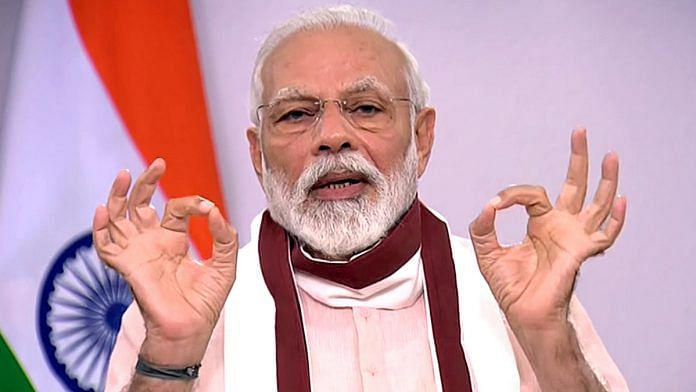The gradual reopening of India’s economy after a 43-day coronavirus lockdown has been marred by a hyper-centralization of decision-making. Deepening mistrust between New Delhi and the 28 states threatens to splinter the country’s common market of 1.3 billion people, its biggest draw for investors.
With infections surging by nearly 50% to cross 70,000 since the shutdown was eased about a week ago, it’s clear that one-size-fits-all rules have been less than a stellar success. They have forced states to sacrifice the little revenue they generate by, among other things, taxing fuel and alcohol. That’s left them fighting for a fair and timely share of dwindling federal resources, and scrambling to raise funds in the bond market.
It’s impossible to conclude that a more localized approach would have contained the pandemic. Still, states left to act on their own might have fared better in lowering both the human cost of the tragedy and its grave economic consequences.
Also read: India Inc expected to struggle for funds as Modi govt steps up its own borrowing
Amarinder Singh, chief minister of the northwestern state of Punjab, begged Prime Minister Narendra Modi on a Monday video conference call to let him have a say in restarting some parts of the industrial centers of Ludhiana and Jalandhar. Both have been marked as red zones by New Delhi, forcing a halt to everything except essential services. Punjab relies heavily on surplus rural labor from less prosperous states in northern and central-eastern India. More than a million out of the 1.3 million who are stuck in Punjab with no jobs or money have signed up to go back home on special trains arranged by the Modi government, Singh said on the call. How can he get them to stay?
States aren’t being unrealistic in demanding more money and a little freedom. No political leader wants to take the risk of getting overwhelmed by Covid-19 by allowing a full reopening just yet. But the western state of Maharashtra, which has seen the greatest spread of the disease, wants Modi to allow the resumption of Mumbai suburban trains — the lifeline of India’s financial and entertainment capital — for workers providing essential services.
States that have succeeded in beating back the virus are also struggling to stay afloat. In the south, Kerala is facing the double whammy of no local production and migrant workers returning from the Middle East. It wants states’ borrowing limit to be raised, and for the central bank to purchase their bonds directly if investors won’t. Kerala Finance Minister Thomas Isaac also wants compensation for the loss of the goods and services tax — something that was promised to states for five years when in 2017 they gave up most local taxes in favor of the nationwide levy. With no money from anywhere, local government spending will collapse, making India’s recovery under a phased reopening a long climb out of a deep hole.
Nomura Research projects India’s real gross domestic product to decline by 5.2% this fiscal year. Most private forecasters agree that the combined budget deficit of federal and state governments may balloon to around 14% of GDP, more than double last year’s 6.5% shortfall. It would surge even more in the absence of urgent government spending to protect growth. That is when the perils of managing a large democracy with a centralized command-and-control structure will become apparent.
This situation is still salvageable. The government, and the central bank, must work with states to make available the resources they need to restart safely. Beg, borrow, or monetize, but find the cash. The bulk of the $265 billion, or 10% of GDP, Modi promised to spend in a Tuesday evening televised address needs to be new expenditure and not a reshuffling of the existing budget. At least some of it has to reach the states. Otherwise, the crunch will spawn harmful ad hocism. Some agrarian states in northern India are so worried about the excess returnee workers from elsewhere that they’re suspending labor laws, hoping to attract the large factories they never got. India’s archaic rules are notorious for encouraging bribery without protecting anyone. But the answer to a bad law isn’t lawlessness. Allowing 12-hour workdays without social security is hardly a blueprint for industrialization in the 21st century.
Even before the Covid crisis, too little income went to labor and too much to providers of capital, outside of India’s bloated public sector. This was coming in the way of ordinary people being able to afford even 7-cent cookies. In the post-virus world, if the price of labor becomes a race to the bottom among states, then upward mobility will suffer and extreme inequality will only worsen. What will be the point of investing in India to tap a diverse yet common market where only a sliver of the population has any spending power? – Bloomberg
Also read: Modi gained popularity in Covid, but real test comes later. Don’t judge a leader in crisis







There is so much ranting in this article and very little substance. Seems like Mr. Mukherjee is a fiction writer than the journalist. Also he forgets that how West Bengal state was fudging the Covid-19 numbers.
Andy lists out the facts, and concludes something quite opposite them. The conclusion is that one – size- fits- all has not worked, while admitting that there was a 50% increase of infection in a week after lockdown was lifted. This increase shows that the states are not competent in managing the containment strategies, thus risking the vast population of the country. That they want the power to decide for themselves on restarting the economy can be understood. But can they be trusted? From what the CMs of Punjab and Maharashtra have asked, it becomes clear that their strategy is not containment but herd immunity, which we have rightly rejected due to the unacceptable high deaths.
Under these circumstances, let us wait and watch the unfolding events.